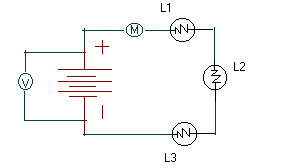BEE
Series Circuits
SERIES LIGHTS
** CAUTION: Working on energized circuits is dangerous and may result in ELECTROCUTION **
Circuits come in three basic flavors, series, parallel and a combination or series/parallel. Each of these can
be evaluated with OHM'S LAW to gain an understanding of their operation.
E = IR I = E/R R = E/I
Simple series circuit having equal value loads (resistance)
The first circuit(ckt.) is the Series Lights ckt.. The voltage("E") applied from the battery is divided between the loads,
each dropping or developing the same voltage across it. The amount of current("I") flowing in the circuit is determined by the total resistance in the circuit.
If the resistance of each light is 10 ohms then the total resistance is 30 ohms. To
simplify the math we will say that the battery is 30 volts. We now have enough information to solve for "I" with
OHM'S LAW.
I = E/R
I = 30volts/30 ohms
I = 1 amp.
The current flow is the same in all parts of a series circuit. Now that we have solved for current and know that
1 amp. is flowing and we know the resistance of each light (10 ohms) we can find the voltage drop across each light.
E = IR
E = 1 amp * 10 ohms
E = 10 volts
The circuit has identical lights, by multiplying 10 volts by 3 lights we get the applied voltage from the battery or
30 volts. The voltage drops across loads in a series circuit equal the applied voltage.
Now that we have this information we will add one more simple equation: P = E*I
where P is power in watts, "E" is voltage and "I" is current.
P = E*I
P = 30*1
P = 30 watts
From this we can divide 30 watts by 3 lights to find that each one is a 10 watt bulb or knowing from the previous
equations that each light drops 10 volts and has 1 amp. of current flow:
P = E*I
P = 10*1
P = 10 watts
If we know the voltage "E" and current "I" we can calculate the circuit resistance "R".
R = E/I
R = 30volts/1 amp.
R = 30 ohms
We have discovered a few rules that apply to series circuits:
1. The current is the same in every part of a series circuit.
2.The current ("I") flowing in a series circuit is determined by the applied voltage
and total or effective resistance in the circuit.
3. The voltage drops across the loads in a series circuit equal the applied voltage.
*********************************************************************************
You can see that with any two values we can find out a lot about the circuit. How do we get this information?
The voltage can be measured with a voltmeter.
The current can be measured with an amp. meter. This is usually the most difficult measurement to take,
the circuit must be opened and the ampmeter connected into the circuit, then the power reapplied.
Resistance reading can be taken with an ohm meter.
***MAKE SURE THAT THE POWER IS OFF***
The surest way to destroy an ohm meter is to use it on a circuit with power applied.
If you are thinking about buying a Multimeter, look for a high impedance, auto ranging digital.
*********************************************************************************
Let's change a few values and go through it once more.
In the last example the lights were all the same. This was to simplify the math. It was more important that you
understood the process.
E = IR I = E/R R = E/I
First the parameters: The voltage is the same 30volts, L1 is 5ohms, L2 is 10ohms, L3 is 15ohms.
The first thing is to find the amount of current flowing in the circuit.
I = E/R
I = 30volts/ 5 ohms(L1) + 10 ohms(L2) + 15 ohms(L3)
I = 30/30
I=1 amp.
Now we have all three parameters. Let's find the voltage drop across each of the lights.
E = IR
E = 1* 5 ohms (L1)
E (L1) = 5 volts
E = IR
E = 1*10 ohms(L2)
E(L2) = 10 volts
E = IR
E = 1* 15 ohms(L3)
E(L3) = 15 volts
Again we know that the current "I" is the same in all parts of a series ckt. and we have calculated the
voltage drops across each of the lights.
(L1) 5volts + (L2) 10volts + (L3) 15volts = (L total) = 30volts
The total voltage drop across the loads of a series ckt. = the applied voltage.
Let's double check our math.
R = E/I
R = 30volts/1amp.
R = 30 ohms
*********************************************************************************
Now, let's break something and trouble shoot it.
If one of the lights burnt open:
How much current would be flowing in the circuit?
The circuit would be open so that no current would flow.
What would be the voltage drop across the good lights?
E = IR
With no "I" flow, there can be no voltage developed. (0 volts)
What would be the voltage across the open light?
Since the circuit is still connected to the battery and there is no "I" current flowing
in the ckt., there are no voltage drops anywhere in the circuit. Therefore we see the
source(battery) voltage across the open light.
Depending on the circumstances, you could trouble shoot this open ckt. with voltage
checks across the lights or by removing the lights individually and checking their
resistance.
*********************************************************************************
We have covered some of the basics, enough to get you off to a good start. I hope you see the
value of OHM'S LAW. You will seldom have need to set down and work out the actual values
in a circuit, but the processes explained above are used every time you trouble shoot a circuit.
If "E" increases then "I" increases.
If "E" decreases then "I" decreases
If "R" increases then "I" decreases
If "R" decreases then "I" increases
(and the fuse blows) hopefully
GOD BLESS, Terry

